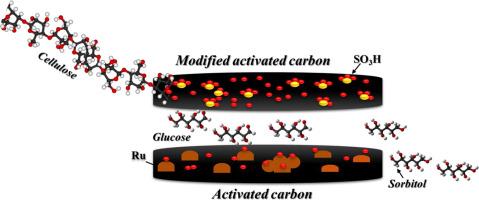在新型串联催化剂上进行生物质选择性转化
IF 13
Q1 MATERIALS SCIENCE, PAPER & WOOD
引用次数: 0
摘要
作为一种生产生物柴油和生物添加剂的可持续工艺,将生物质选择性转化为目标分子(如多元醇),特别是纤维素化合物,正受到广泛研究。已知的工艺包括两个步骤,即水解和氢化。因此,它需要两种不同的催化材料或双功能催化剂。在此背景下,本研究报告了一种基于串联催化剂的新催化方法,由酸性固体催化剂(水解活性)和支撑金属催化剂(氢化活性)组合而成。我们测试了两种不同的功能化活性碳和树脂 Amberlyst 15 作为固体酸催化剂,而支撑在原始活性碳(SA)上的纳米 Ru 颗粒则是串联催化剂中的金属催化剂部分。与支撑的 Ru 催化剂相比,所有测试的串联催化剂都表现出更高的活性。一种新型串联催化剂的纤维素转化率和对山梨醇的选择性最高(分别为 70% 和 86%),这种催化剂是由硫酸改性活性炭(SASu)和负载 Ru 的活性炭(Ru/SA)物理混合而成,从而形成一种串联催化剂(Ru/SA+SASu)。这种设计新颖的串联催化剂可重复使用。基于固-固系统组合的串联催化剂,所采用的新型设计催化方法具有成本效益和可持续性,在绿色生产高附加值化学品方面大有可为。本文章由计算机程序翻译,如有差异,请以英文原文为准。

Selective biomass conversion over novel designed tandem catalyst
Selective conversion of biomass into targeted molecules like polyols, especially, from cellulosic compounds, is being widely investigated as a sustainable process to produce biodiesel and bio-additives. The known process involves two steps, namely hydrolysis and hydrogenation. Thus, it requires two different catalytic materials or bifunctional catalysts. In this context, the present work reports a new catalytic approach based on the use of tandem catalysts, consisting of the combination of an acid solid catalyst (active for hydrolysis) and a supported metal catalyst (active for hydrogenation). Two different functionalized activated carbons and the resin Amberlyst 15 have been tested as solid acid catalysts, and Ru nanoparticles supported on the original activated carbon (SA) are the metal catalyst part of the tandem. All the tested tandem catalysts exhibited higher activity than the supported Ru catalyst did. The highest cellulose conversion and selectivity to sorbitol (70% and 86%, respectively) have been obtained over a novel tandem catalyst, which resulted from a physical mixture between a sulfuric acid modified SA carbon (SASu) and Ru loaded SA (Ru/SA), leading to a tandem catalyst (Ru/SA+SASu). This novel-designed tandem catalyst is reusable. Based on tandem catalysts with a solid-solid system combination, the adopted novel-designed catalytic approach is cost-efficient and sustainable, and can be considered promising for the green production of high-added-value chemicals.
求助全文
通过发布文献求助,成功后即可免费获取论文全文。
去求助
来源期刊

Journal of Bioresources and Bioproducts
Agricultural and Biological Sciences-Forestry
CiteScore
39.30
自引率
0.00%
发文量
38
审稿时长
12 weeks
 求助内容:
求助内容: 应助结果提醒方式:
应助结果提醒方式:


